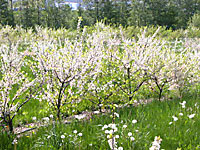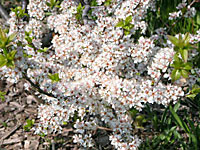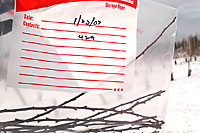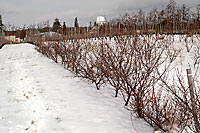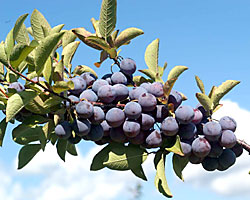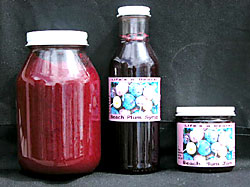
|
Beach Plum Updates | |||
|
Home page
Topics on this page: plum |
Have beach plum news? Email Tom Whitlow: thw2@cornell.edu 2007 harvest [9/11/2007] Another bumper cropat the Cornell Orchard plantings, reports Tom Whitlow. "I estimate that we'll easily get 800 pounds despite the low rainfall." He also says fruit is ripening about a week earlier than last year. The Cornell Orchards Store is selling beach plum jam and syrup. Stop by and buy some along with apples and other fruit.  Buckets of fruit.  A loaded bush. 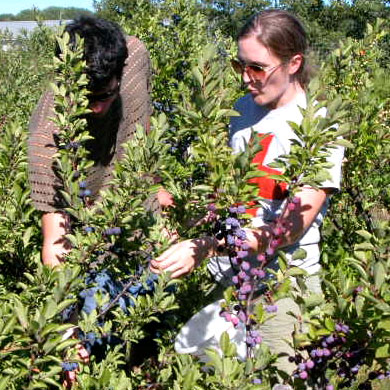 Harvesting fruit. Making the menu [6/18/2007]  Beach plums have made the menu at Red Newt Cellars Winery and Bistro in Hector, N.Y., 10 miles north of Watkins Glen: Beach plums have made the menu at Red Newt Cellars Winery and Bistro in Hector, N.Y., 10 miles north of Watkins Glen:Grilled bacon wrapped pork tenderloin stuffed with chevre, pork sausage, chard with a beach plum sauce served with roasted garlic grits and seasonal vegetable. Deb Whiting, Executive Chef at the bistro, which overlooks Seneca Lake in the heart of the Finger Lakes, loves to use unusual local ingredients, says Tom Whitlow, beach plum expert in Cornell's Department of Horticulture. He provided the puree made from the trees of wide-ranging provenance at Cornell Orchards. Although beach plum's native range is restricted to coastal dunes, it grows quite well in Upstate New York, reports Whitlow. If the Finger Lakes are on your summer travel plans, visit the Red Newt Bistro for this and other artfully prepared locally produce. Top
[5/23/2007] We again are having an excellent year for flowering and have had no floral abortion due to late frosts. The orchard is buzzing with both native solitary bees and European honeybees from commercial hives, so we anticipate good pollination. Top  800 pounds of jam ... [5/23/2006]
800 pounds of jam ... [5/23/2006]During the second week in May, Tom Whitlow spent two days at the Pilot Plant at the Geneva Experiment Station and made nearly 800 pounds of jam, syrup and puree from last fall's harvest. Banfi's Rerstaurant in Cornell's Statler Hotel and the Red Newt Bistro in Lodi will be featuring beach plum dishes on their early summer menus if you are travelling in the Finger Lakes region. Top
In January, Rick Uva and Tom Whitlow collected scions from consistently good shrubs to graft onto seedling understocks. These have been distributed to the Beach Plum Advisory Committee and will eventually become cultivars. Top 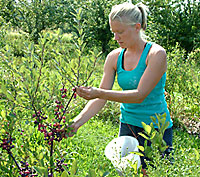 Beach plum featured in Cornell Chronicle [9/18/2006]
Beach plum featured in Cornell Chronicle [9/18/2006]Rebecca Harbut (right), graduate student graduate student in Cornell University's Department of Horticulture, harvests beach plums at Cornell Orchards. Cornell Chronicle featured beach plums in its Sept. 15 issue. Read the beach plum article. Top Good growth [7/17/2006] 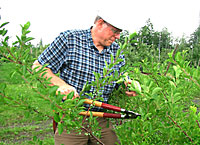 Dr. Tom Whitlow pruning beach plums. We have very vigorous growth and excellent fruit set in our provenance orchard. We conducted a summer pruning on July 13 to improve tractor access in the alleys and reduce fruit load. The orchard has been sprayed twice this season to combat brown rot. Dr. Tom Whitlow pruning beach plums. We have very vigorous growth and excellent fruit set in our provenance orchard. We conducted a summer pruning on July 13 to improve tractor access in the alleys and reduce fruit load. The orchard has been sprayed twice this season to combat brown rot.Top Beach Plum on menu at Trumansburg bistro [5/16/2006] Chef Samantha Izzo of Simply Red Village Bistro in Trumansburg, N.Y. has added a beach plum panecota to her desert selections for May. Panecota is a light Italian custard made from fruit puree and buttermilk. Check it out at the Simply Red website. Better yet, visit Simply Red and try it in person! Top Full force pollination [5/12/2006] 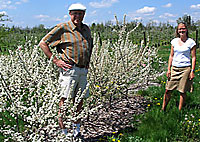 Dr. Tom Whitlow and grad student Rebecca Harbut observe the heavy bloom in our provenance garden at Cornell Orchards in early May, 2006. "Pollinators are out in full force and we are optimistic about fruit set," says Whitlow. Dr. Tom Whitlow and grad student Rebecca Harbut observe the heavy bloom in our provenance garden at Cornell Orchards in early May, 2006. "Pollinators are out in full force and we are optimistic about fruit set," says Whitlow.Top 2005 Harvest from Cornell Provenance Orchard [4/14/2006]
We washed and froze the fruit, awaiting some interlude when we had time to process it into jam, syrup and puree. This time finally came during Spring Break when we could spend two days in the pilot food plant at the Experiment Station in Geneva, NY. The jam and syrup will go on sale next fall for at the Cornel Orchard Store and puree has been given to local restaurants for experimentation. Upon receiving some puree, Red Newt Bistro (webmaster@rednewt.com ) on Seneca Lake wasted no time in incorporating it into their seasonal menu as a sauce served over pan-seared duck. Top Connecticut plantings [4/11/2006] Here's an update from Abby Maynard, Department of Forestry and Horticulture at the Connecticut Agricultural Experiment Station, Abigail.Maynard@po.state.ct.us: In 2003, we planted seedlings supplied by Cornell at our two farms. We planted 175 seedlings from 35 sites at our farm in Hamden, CT (which has more room). Until this year, we have had a deer browse problem at this site. We did not have any browse this last winter (thanks to a new fence) and it looks like most will be blooming this spring. In Windsor, CT, we planted 92 seedlings from two sites (Oceanside and New Hampshire). Last summer (2005), we had fruit on greater than 80% of the plants with yields as much as 10.6 lbs/plant. This site has had no deer problems (fence has been up since the start). The farm manager has treated the trees, as far as weed and pest control are concerned, like a Japanese plum orchard at the same site. All the sprays and fertilizing were done at the correct time and we had beautiful fruit. It is amazing how much growth those trees have put on in just three years. I think you are correct in saying in the SARE report that the beach plums should be treated as a orchard. We were lucky in that our farm manager is used to taking care of orchards. Even though beach plums can survive in a harsh environment, any commercial operation must follow all the weed and pest controls of any other plum orchard. If you are interested, I can send you more details of our results and of sprays etc. that were used. I am looking forward to seeing what happens this year. Top |

